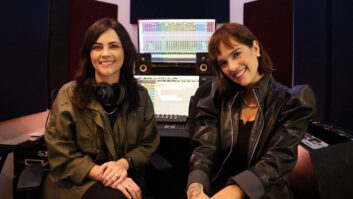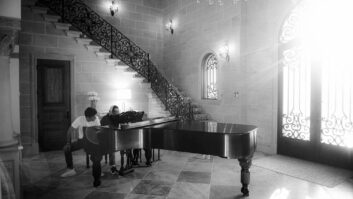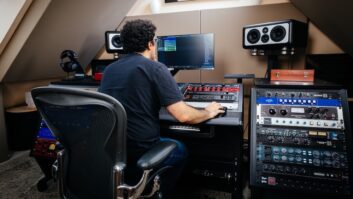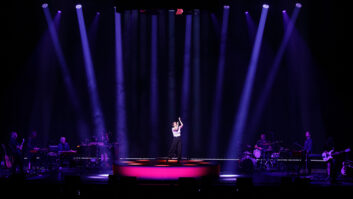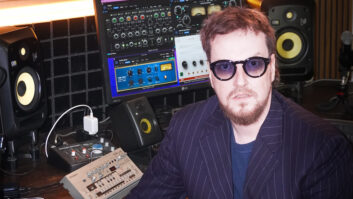

“I like Doris Day, she’s a good person,” says Nellie McKay (pronounced “Mc-KIGH”) of one of her vocal icons. “I’m a member of both her Animal League and Foundation. But then, her style and asexual persona have had an appeal for many women.”
Thus is the dichotomy that is Nellie McKay, the street-wise young songwriter/performer who is garnering great notice throughout the music world. Her quirky music bounces alternately between smooth (and well-executed) jazz, rap and cute songs that, on the surface, come from the young girl singing them, but have the deeper social messages of a mature woman.
Stuart Breed (left) and Geoff Emerick
Now, jazz and rap aren’t the types of music one usually associates with Geoff Emerick. “This is my first rap recording!” he says with a proud grin. Emerick, the engineering and/or production genius behind artists such as The Beatles, Badfinger, America, Elvis Costello and Art Garfunkel, added those genres to his already long list of accomplishments with the Columbia release of Get Away From Me, McKay’s critically lauded two-disc set.
“I was attracted to the lyrics immediately,” Emerick says. “Elvis Costello immediately came to mind.” McKay’s songs have both a child-like sweetness and a hard-edged bite, reminiscent at once of both Doris Day and Eminem, as one critic noted. “Her level of maturity at such a young age is astounding,” Emerick says of the 19-year-old. “You come across an artist of this caliber once every 10 or 15 years. And I don’t do a lot of projects these days unless something really stands out like this did.”
Emerick was introduced to McKay via a set of self-recorded demos in which she played solo on piano (as she usually performs live) with added synthesized instrumentation. “Her talent was quite evident to me immediately,” he says. Then, in early August 2003, and with Emerick in attendance, McKay rehearsed for two days in a Manhattan rehearsal studio with a group of jazz musician friends before formal recording sessions began. “At first, I was a little bit concerned because we just had the jazz guitar, drums, bass and Nellie on piano, and I thought we might need a straight rhythm guitar,” Emerick says. “But I decided that it was most important to focus on the lyrics, so after a short while, it didn’t really bother me not having that other guitar.”
Basic tracking took place at New York’s Clinton Recording Studios, where Emerick could stay in familiar analog territory with the studio’s Neve 8078 consoles. “I wanted to use Neve equipment,” he says. “I’m a Neve person. Neve desks are musical to my ear; they’ve got a musical depth to them.” The sessions were tracked on Studer analog 24-track tape machines without Dolby at 30 ips on Ampex tape. “I was a little bit concerned about print-through, especially during quiet passages, but luckily, there were no problems.”
Emerick was assisted on the sessions by Stuart Breed, with whom he had worked on a number of projects in the mid-1980s, including Garfunkel’s The Animals’ Christmas and Lefty. (Breed has been Garfunkel’s sound engineer for the past 20 years.) “I wanted Stuart’s analog experience. We had worked together in England at AIR Studios,” says Emerick. Adds Breed, “We hadn’t worked together since 1986, so I jumped at the opportunity.”
McKay and combo recorded four songs each day from August 4 through 6 in Clinton’s Studio B, recording overdubs there the rest of the week before moving upstairs to the roomier Studio A. Six more tracks were cut — all using upright bass this time — the following Monday, with overdubbing, including string and brass one day, during the next two weeks including the 17th, the day of New York’s last power blackout.
Basic tracking found the group performing live, complete with live vocals by McKay. “My approach with this, because it was jazz, was simply to go by feel,” explains Emerick. “There was no click track; I didn’t want to bring any computers into it.” And, yes, that is a real drum loop heard on several tracks made from a two-bar drum take spliced together on quarter-inch tape and played on a tape machine with a pair of drumsticks, etc., to create a tape path. “You know, like ‘Tomorrow Never Knows?’” recalls Emerick of his famous experiment for The Beatles’ 1966 Revolver album.
The biggest headache with live recording was separation. “Since there was no click track, we wanted to keep everyone as close as possible so they could have eye contact, like they would if they were playing in a jazz club,” says Breed. “We achieved it with a lot of glass-panel screening and a ton of packing blankets on Nellie’s piano.” Notes Emerick, “With the live vocals, we needed to get enough separation to avoid any ghost voice on the piano mics” — a hallmark of many a pre-Emerick Beatle recording — “to allow for any later vocal fixes.”
Instruments were miked, for the most part, with tube (or “valve,” as the two English engineers call them) mics. “We always had the concern that these things might start fading out or get low hums,” says Breed, “so that was something we paid quite a lot of attention to.”
Geoff Emerick isolated Nellie McKay’s piano with blankets while tracking at Clinton Recording (N.Y.).
Underneath all of the packing blankets over the piano were a pair of AKG C 12 mics, while the upright bass was handled by a Neumann U47 placed near the F-hole. For drums, Breed — shifting from rock mode to jazz mode — tried a Shure SM7 on the kick drum before switching to an AKG D-112. “I like the real low bass response of the SM7, but it really wasn’t needed for the drum kit that we had,” Breed says. “It’s normally really great at picking up all those little passing drum notes you get in jazz — the air moving rather than the sound.” But the D-112 did the trick. “On some of these tracks, you can hear every different tone coming off of it. It’s like the bass drum that every rap artist tries to get, which they get by layering different drums. With this, the guy would hit the bass drum and you heard the air that followed.”
For overheads, Emerick used Cole 4038 ribbon mics for the more electric tracks, switching to AKG 414s for the lighter jazz songs. “The 414 is better at grabbing the texture at that lower level, though 4038s pick up an excellent drum sound with a high-end boost,” he says.
A particular challenge to the team was capturing the great number of percussion instruments that the formally trained McKay plays on the album. “I really do have an affinity for the mallet instruments,” she says, “so I was glad to be able to play them on this record.” Emerick notes that on tracks such as “Baby Watch Your Back,” McKay exhibited her true virtuosity. “We miked her doing a vibe solo in stereo and double-tracked it. When you hear her play that solo at the speed she’s playing — twice — it’s quite unbelievable,” he says. “And the vibes are kind of difficult to record. They have a lot of harmonics, so there’s a lot of electrical meter value but they don’t sound very loud, so you have to craft the track around it.”
Also difficult was the glockenspiel, which appears throughout the album. “With the range on that instrument, it can play havoc with the tape,” explains Breed. “You have to be very, very careful with miking and with the level you put it onto the tape. It can spill over to adjacent tracks, and if you don’t record it right, it can cause everything to sort of wobble because of the high pitch.”
But perhaps the most important “instrument” that was miked was McKay herself, whose sultry voice easily places the listener in a smoky nightclub at two in the morning surrounded by empty martini glasses. “It was interesting, because this was her first time in a professional recording studio,” explains Emerick. “Being so young, she didn’t yet have a professional mic technique. Pops were a bit of a problem, but we managed to get rid of those in the end.”
For miking McKay, Emerick went with different microphones and compression, depending on the track. “To start with, we set up a U47, obviously a U67, a U87 and an M49. I ended up recording most of her vocals on a 49, because the other mics tended to make her voice sound very telephone-y because of that little lift at about 2k. The 49 gave it a bit more warmth.” For compression, Emerick started with a Teletronix LA-2A before switching to another old favorite, a UREI 1176. “I like to over-compress,” he says. “I tried to under-compress when I first started with these songs, but then realized that the dynamics within them were so big that I needed better control rather than just taking off the peaks.”
While some songs feature McKay at her best Billie Holiday, such as “I Wanna Get Married,” which she describes as “one big experiment in breath control,” others, such as “Sari” and “Work Song,” contain incredibly long lyric lines sung in more of a rap style. “Most of those she would get down in complete takes,” recalls Emerick, though the occasional fix was still required, thanks to nimble punch-ins by Breed. “I had some very tight punch-ins, and I was going in and out for words,” Breed says. “I’d much rather fix it in the moment rather than wait and set up another track for just one word. I find that if I go back and punch immediately, feeling the artist’s breath and what they’re doing, I can nail it. I find it very exciting; Geoff finds it suicidal!”
The source of most of the spectacularly creative vocal overdubs and harmonies was McKay herself. “We’d be doing a harmony and suddenly another harmony would come into her mind,” says Emerick. “So it was quite spontaneous. Unbelievable, really.” McKay’s arranging skills are particularly notable, considering she normally plays live without any accompaniment. “I’d done a few vocal jazz charts in college and did a big band chart in high school,” she explains. “I do everything on piano. You just sing it or you play it, and that’s how you avoid interfering chords.”
Notes Breed, “Nellie’s approach to building backing vocals is much like the way Rickie Lee Jones did it back in the 1980s. She’d start on the third and then work her way out from there. It would start kind of strange, but then as she’d put other notes around it and build it up, you suddenly end up with this wall of great vocals. And Nellie is spot-on.”
That building-up process eventually led to, on some songs, running 72 tracks on three machines when work shifted to Capitol Records at the end of August, continuing through September into early October. “It was always intended to mix at Capitol,” says Emerick, who had been working in the facility’s Studio B with another band, The Syrups. “It’s always my first choice. Analog, to them, is no problem. And the maintenance backup is so good. You want three 24s? No problem.”
Both overdubbing and mixing took place in Studio B. “They’re really quite complex tracks,” notes Emerick, particularly those spanning three machines. “Even though they had a simple jazz backing, blending all those harmonies was quite a challenge. I typically spent one-and-a-half to two days per track.” Emerick took particular care with the vocals, especially with the diction of the sometimes complicated lyric lines. “Her lyrics are everything, so I was very careful to make sure not a word got lost.” For his West Coast work, Emerick was assisted by Capitol’s Steve Genewick and Bill Smith, who worked off of notes prepared by Breed from the New York sessions.
Once mixing was completed, Emerick brought the finished recording to his favorite mastering engineer, Greg Calbi, at Sterling Sound. “He was the only man who could polish this off and put a final stamp on it,” he says, adding, “I’m sure this is a mastering session he will never forget,” a smile no doubt hiding some colorful story.
Though the album spans two discs, its running time is only about 60 minutes. So why a double-album? “It’s not a double-album; it’s a single album,” Emerick insists. “Nellie wanted to do all 18 songs and the record company wouldn’t accept 18 tracks. So we suggested splitting it onto two discs.” The design harkens to Emerick’s vinyl days. “You’d listen to side 1, and you’d have a respite between sides, maybe have a cup of tea, and then you’d listen to side 2. With CDs, you ram all this information in one play, leaving the listener to randomly think, ‘Oh, I’ll stop here,’ which might not be the right place you’d want them to stop. To me, this makes a lot more sense,” he explains, noting that McKay was equally behind the idea, “fighting tooth and nail for it,” to the point of absorbing the cost out of her own pocket.
Having a double-sided album was not out of line with McKay’s persona and music. Says Breed, “Some of her music might take some getting used to, but the only reason it takes getting used to is because it’s different. And that’s a good thing.”
Of her work with Emerick, McKay concludes, “I have a feeling every job is hard for Geoff. He commits himself to it and he’s a worrier. He really believes in it, and he really respects the person who’s written the work. If being an artist and working as a musician is akin to having a drug problem, he’s a great enabler.”

• To read Maureen Droney’s interview with legendary producer Geoff
Emerick, click
here.
• To hear song clips from Nellie McKay’s album, Get Away From
Me, click
here.


